Do you have a question about the Panasonic DMR-E60 and is the answer not in the manual?
Overview of the remote control buttons and their functions.
Identification of the main unit's buttons, terminals, and indicators.
Detailed explanations of each remote control button's operation.
Identification of the main unit's components and their functions.
Explanation of indicators showing recording, playback, and media status.
Understanding indicators for disc types and recording modes.
Critical safety warnings regarding laser exposure, fire, and electric shock.
Important notes on proper unit handling, ventilation, and disposal.
List of items provided with the DVD recorder and their descriptions.
Important safety instructions and precautions for the AC mains lead.
Instructions for inserting batteries and proper remote control operation.
Guidance on optimal remote control range and operating conditions.
Procedures for programming the remote to control your TV.
Methods for selecting the AV input on your TV using the remote.
Information on discs compatible with the unit for recording and playback.
Details on discs that can only be played, not recorded on, and their logos.
Explanation of DVD region codes and important notes on disc usage.
List of incompatible disc types and explanation of audio format logos.
Guidance on disc playback compatibility with TV systems (PAL/NTSC).
Information on compatible SD/PC cards and FAT file system support.
Details on compatible still picture formats and file/folder limitations.
Step-by-step guide for connecting aerials, satellite receivers, and TVs.
Instructions for connecting the unit to the TV and satellite receiver via AV Scart.
Method for connecting without Scart leads, using RF connections for TV and receiver.
Guide for connecting using an S-Video cable for better picture quality.
Instructions for recording from satellite receivers using specific functions.
Step-by-step guide for initial setup with a new Q Link compatible TV.
Procedure for setting the Owner ID and PIN number during initial setup.
Instructions for setting up with a TV that already has Q Link functionality.
Steps for performing Auto Setup when Q Link is not available.
Steps to adjust RF output channel to eliminate picture interference.
Guide for teaching the unit Video Plus+ codes for satellite stations.
How to set the TV aspect ratio for optimal viewing on your television.
How to play discs, navigate menus, and stop playback.
Procedure for erasing a programme that is currently being played.
Using Quick View, Resume, and search functions for efficient playback.
Techniques for slow-motion and frame-by-frame viewing during playback.
How to skip through programmes, tracks, or chapters.
Using Time Slip for skipping time and starting playback from specific points.
How to select different audio tracks or languages during playback.
Setting markers to easily return to specific points on a disc.
Procedures for clearing markers and removing display menus.
How to play MP3 files from discs, including folder and file navigation.
Requirements for recording, including disc types and recording modes.
Explanation of recording modes (XP, SP, LP, EP) and checking recording time.
Using FR to optimize recording time and picture quality.
Simple method for setting a time to stop recording.
Immediately recording the programme currently being watched.
Controlling recording via external equipment using EXT LINK.
Playing a programme from the beginning while it is still recording.
Playing recorded programmes or other content while recording.
Monitoring recording progress and checking previously recorded parts.
How to watch TV channels while a recording is in progress.
Understanding the purpose and display of the Functions window.
Information shown on the disc display within the Functions window.
Accessing disc details, timer recording, and setup menus via the Functions window.
Accessing JPEG functions, navigation tools, and play list management.
Functions for flexible recording and accessing the top menu.
Programming timer recordings using VIDEO Plus+ codes.
Modifying settings for scheduled timer recordings.
Using PDC to automatically adjust recording start/stop times.
Setting up timer recordings manually without using special codes.
Reviewing, clearing, and managing scheduled timer recordings.
Procedures for managing active and scheduled timer recordings.
Connecting and recording from VCRs and DV equipment.
Setting the TV system (PAL/NTSC) for optimal recording.
How to enter titles for discs, programmes, or play lists and edit them.
Entering disc titles and setting disc protection against erasure.
Removing all recorded programmes and play lists from a disc.
Erasing and preparing discs (especially DVD-RAM) for use.
Converting DVD-R recordings to DVD-Video for playback on other devices.
Navigating and selecting recorded programmes from a list.
Explanation of the information displayed in the Direct Navigator list.
Procedures for erasing programmes and editing their titles.
Viewing details and properties of selected programmes.
Setting write protection to prevent accidental erasure.
Removing specific sections from a recorded programme.
Splitting a programme into two separate segments.
Viewing and creating custom play lists of scenes.
Specifying scenes and their order to create a play list.
How to select and play a previously created play list.
Selecting and playing specific scenes within a play list.
Incorporating new scenes into an existing play list.
Changing the order of scenes in a play list.
Modifying the start and end points of scenes within a play list.
Removing scenes or entire play lists from storage.
Copying play lists, adding titles, and checking their contents.
General steps for using display menus and navigating disc menus.
Choosing audio tracks, subtitles, and angles during playback.
Adjusting picture modes, sound settings, and DNR.
Enabling repeat playback for discs or segments.
Procedures for handling SD/PC cards and selecting storage locations.
Information on supported file systems and still picture formats.
Displaying pictures in an album format or as an automatic slide show.
Options for erasing still pictures and rotating their display orientation.
Copying individual pictures or entire folders to another location.
Removing selected still pictures or folders from storage.
Copying all data from an SD/PC card to DVD-RAM.
Protecting files from accidental erasure or releasing protection.
Setting up print options for still pictures using DPOF.
Adjusting slide show timing and formatting memory cards.
Setting up automatic recording from DV equipment.
How to manually stop the DV auto recording process.
Activating and deactivating the Child Lock feature.
Connecting equipment for Dolby Digital and DTS surround sound.
Instructions for connecting digital and analog amplifiers and system components.
How to connect a decoder device for Pay TV.
Steps for connecting satellite or digital receivers.
How to connect VCRs to the unit's AV or DV input terminals.
General steps to access and navigate the unit's settings menu.
Summary of initial settings for tuning, clock, owner ID, and shipping condition.
Configuration options for disc playback languages and audio.
Adjusting picture sharpness, sound modes, and display options.
Configuring digital audio output and DV input audio modes.
Adjusting TV aspect ratio and selecting the TV system (PAL/NTSC).
Configuring AV settings and connection types like DECODER and Ext Link.
Limiting playback based on ratings and managing passwords.
Settings for PCM Down Conversion, Dolby Digital, DTS, and MPEG output.
Setting the remote control mode for operating the unit or other Panasonic devices.
Manually setting the unit's internal clock.
Enabling and using the auto clock setting feature.
Procedures for manually tuning TV channels and handling the tuning box screen.
Managing channel lists by adding, deleting, or reordering channels.
Restarting auto setup or downloading data when initial setup fails.
Modifying owner ID details and resetting unit to factory settings.
How to change and interpret information displayed on the screen.
Examples of various status displays and their meanings.
Instructions for cleaning the unit, lenses, and discs.
Guidelines for safe handling, avoiding damage, and proper storage of discs.
Definitions for terms like Bitstream, Dolby Digital, DTS, JPEG, LPCM, PBC.
Definitions for terms like Play List, Programme, RGB Output, and TIFF.
Explanations of Q Link, PDC, Title/Chapter, and Track terminology.
Interpreting service numbers and unit statuses indicating problems.
Listing error messages and their corresponding causes and solutions.
Solutions for problems related to power, no picture, or picture quality.
Troubleshooting steps for no sound, low volume, or distorted audio.
Solutions for issues with dim displays, flashing clocks, and playback failures.
Troubleshooting problems with the remote control and basic operation.
Solutions for recording failures and timer recording issues.
Problems related to reading card contents and editing still pictures.
Technical specifications for power, recording systems, and recordable discs.
Details on audio features, video interfaces, laser specifications, and dimensions.
Overview of the remote control buttons and their functions.
Identification of the main unit's buttons, terminals, and indicators.
Detailed explanations of each remote control button's operation.
Identification of the main unit's components and their functions.
Explanation of indicators showing recording, playback, and media status.
Understanding indicators for disc types and recording modes.
Critical safety warnings regarding laser exposure, fire, and electric shock.
Important notes on proper unit handling, ventilation, and disposal.
List of items provided with the DVD recorder and their descriptions.
Important safety instructions and precautions for the AC mains lead.
Instructions for inserting batteries and proper remote control operation.
Guidance on optimal remote control range and operating conditions.
Procedures for programming the remote to control your TV.
Methods for selecting the AV input on your TV using the remote.
Information on discs compatible with the unit for recording and playback.
Details on discs that can only be played, not recorded on, and their logos.
Explanation of DVD region codes and important notes on disc usage.
List of incompatible disc types and explanation of audio format logos.
Guidance on disc playback compatibility with TV systems (PAL/NTSC).
Information on compatible SD/PC cards and FAT file system support.
Details on compatible still picture formats and file/folder limitations.
Step-by-step guide for connecting aerials, satellite receivers, and TVs.
Instructions for connecting the unit to the TV and satellite receiver via AV Scart.
Method for connecting without Scart leads, using RF connections for TV and receiver.
Guide for connecting using an S-Video cable for better picture quality.
Instructions for recording from satellite receivers using specific functions.
Step-by-step guide for initial setup with a new Q Link compatible TV.
Procedure for setting the Owner ID and PIN number during initial setup.
Instructions for setting up with a TV that already has Q Link functionality.
Steps for performing Auto Setup when Q Link is not available.
Steps to adjust RF output channel to eliminate picture interference.
Guide for teaching the unit Video Plus+ codes for satellite stations.
How to set the TV aspect ratio for optimal viewing on your television.
How to play discs, navigate menus, and stop playback.
Procedure for erasing a programme that is currently being played.
Using Quick View, Resume, and search functions for efficient playback.
Techniques for slow-motion and frame-by-frame viewing during playback.
How to skip through programmes, tracks, or chapters.
Using Time Slip for skipping time and starting playback from specific points.
How to select different audio tracks or languages during playback.
Setting markers to easily return to specific points on a disc.
Procedures for clearing markers and removing display menus.
How to play MP3 files from discs, including folder and file navigation.
Requirements for recording, including disc types and recording modes.
Explanation of recording modes (XP, SP, LP, EP) and checking recording time.
Using FR to optimize recording time and picture quality.
Simple method for setting a time to stop recording.
Immediately recording the programme currently being watched.
Controlling recording via external equipment using EXT LINK.
Playing a programme from the beginning while it is still recording.
Playing recorded programmes or other content while recording.
Monitoring recording progress and checking previously recorded parts.
How to watch TV channels while a recording is in progress.
Understanding the purpose and display of the Functions window.
Information shown on the disc display within the Functions window.
Accessing disc details, timer recording, and setup menus via the Functions window.
Accessing JPEG functions, navigation tools, and play list management.
Functions for flexible recording and accessing the top menu.
Programming timer recordings using VIDEO Plus+ codes.
Modifying settings for scheduled timer recordings.
Using PDC to automatically adjust recording start/stop times.
Setting up timer recordings manually without using special codes.
Reviewing, clearing, and managing scheduled timer recordings.
Procedures for managing active and scheduled timer recordings.
Connecting and recording from VCRs and DV equipment.
Setting the TV system (PAL/NTSC) for optimal recording.
How to enter titles for discs, programmes, or play lists and edit them.
Entering disc titles and setting disc protection against erasure.
Removing all recorded programmes and play lists from a disc.
Erasing and preparing discs (especially DVD-RAM) for use.
Converting DVD-R recordings to DVD-Video for playback on other devices.
Navigating and selecting recorded programmes from a list.
Explanation of the information displayed in the Direct Navigator list.
Procedures for erasing programmes and editing their titles.
Viewing details and properties of selected programmes.
Setting write protection to prevent accidental erasure.
Removing specific sections from a recorded programme.
Splitting a programme into two separate segments.
Viewing and creating custom play lists of scenes.
Specifying scenes and their order to create a play list.
How to select and play a previously created play list.
Selecting and playing specific scenes within a play list.
Incorporating new scenes into an existing play list.
Changing the order of scenes in a play list.
Modifying the start and end points of scenes within a play list.
Removing scenes or entire play lists from storage.
Copying play lists, adding titles, and checking their contents.
General steps for using display menus and navigating disc menus.
Choosing audio tracks, subtitles, and angles during playback.
Adjusting picture modes, sound settings, and DNR.
Enabling repeat playback for discs or segments.
Procedures for handling SD/PC cards and selecting storage locations.
Information on supported file systems and still picture formats.
Displaying pictures in an album format or as an automatic slide show.
Options for erasing still pictures and rotating their display orientation.
Copying individual pictures or entire folders to another location.
Removing selected still pictures or folders from storage.
Copying all data from an SD/PC card to DVD-RAM.
Protecting files from accidental erasure or releasing protection.
Setting up print options for still pictures using DPOF.
Adjusting slide show timing and formatting memory cards.
Setting up automatic recording from DV equipment.
How to manually stop the DV auto recording process.
Activating and deactivating the Child Lock feature.
Connecting equipment for Dolby Digital and DTS surround sound.
Instructions for connecting digital and analog amplifiers and system components.
How to connect a decoder device for Pay TV.
Steps for connecting satellite or digital receivers.
How to connect VCRs to the unit's AV or DV input terminals.
General steps to access and navigate the unit's settings menu.
Summary of initial settings for tuning, clock, owner ID, and shipping condition.
Configuration options for disc playback languages and audio.
Adjusting picture sharpness, sound modes, and display options.
Configuring digital audio output and DV input audio modes.
Adjusting TV aspect ratio and selecting the TV system (PAL/NTSC).
Configuring AV settings and connection types like DECODER and Ext Link.
Limiting playback based on ratings and managing passwords.
Settings for PCM Down Conversion, Dolby Digital, DTS, and MPEG output.
Setting the remote control mode for operating the unit or other Panasonic devices.
Manually setting the unit's internal clock.
Enabling and using the auto clock setting feature.
Procedures for manually tuning TV channels and handling the tuning box screen.
Managing channel lists by adding, deleting, or reordering channels.
Restarting auto setup or downloading data when initial setup fails.
Modifying owner ID details and resetting unit to factory settings.
How to change and interpret information displayed on the screen.
Examples of various status displays and their meanings.
Instructions for cleaning the unit, lenses, and discs.
Guidelines for safe handling, avoiding damage, and proper storage of discs.
Definitions for terms like Bitstream, Dolby Digital, DTS, JPEG, LPCM, PBC.
Definitions for terms like Play List, Programme, RGB Output, and TIFF.
Explanations of Q Link, PDC, Title/Chapter, and Track terminology.
Interpreting service numbers and unit statuses indicating problems.
Listing error messages and their corresponding causes and solutions.
Solutions for problems related to power, no picture, or picture quality.
Troubleshooting steps for no sound, low volume, or distorted audio.
Solutions for issues with dim displays, flashing clocks, and playback failures.
Troubleshooting problems with the remote control and basic operation.
Solutions for recording failures and timer recording issues.
Problems related to reading card contents and editing still pictures.
Technical specifications for power, recording systems, and recordable discs.
Details on audio features, video interfaces, laser specifications, and dimensions.
| Type | DVD Recorder |
|---|---|
| Video System | NTSC |
| Video Input | Composite, S-Video, Component |
| Video Output | Composite, S-Video, Component |
| Recording Format | DVD-RAM, DVD-R |
| Playback Formats | DVD-Video, DVD-RAM, MP3, JPEG |
| Audio | Dolby Digital |
| Audio Output | Optical |
| Tuner | NTSC |


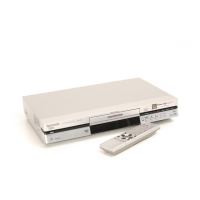
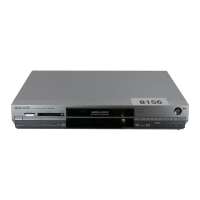
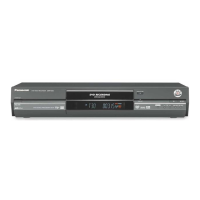
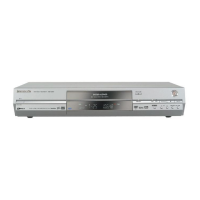



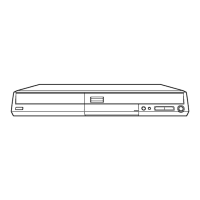

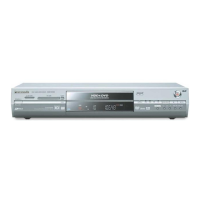
